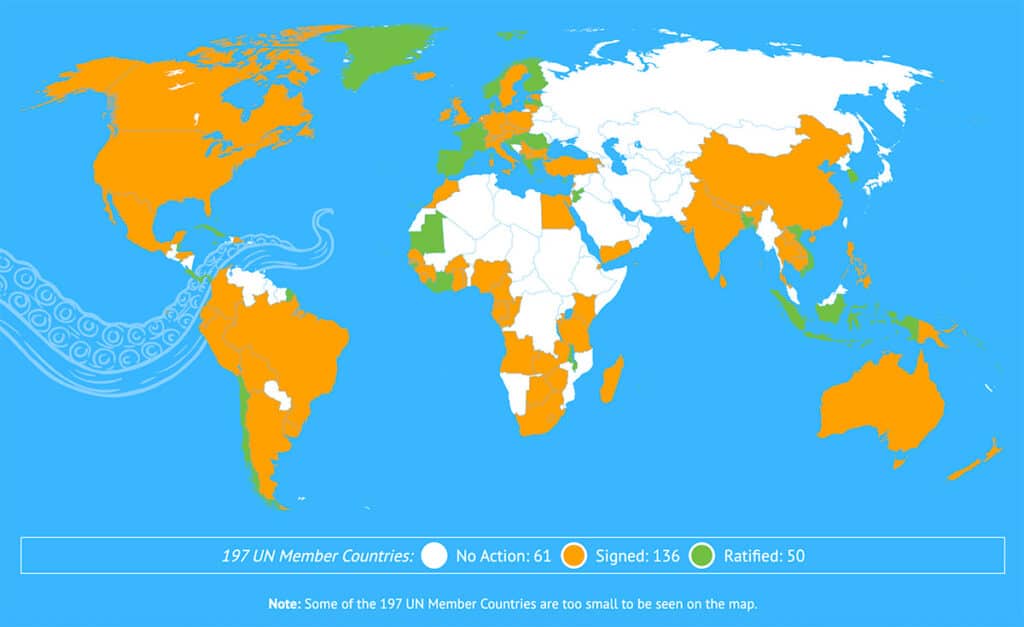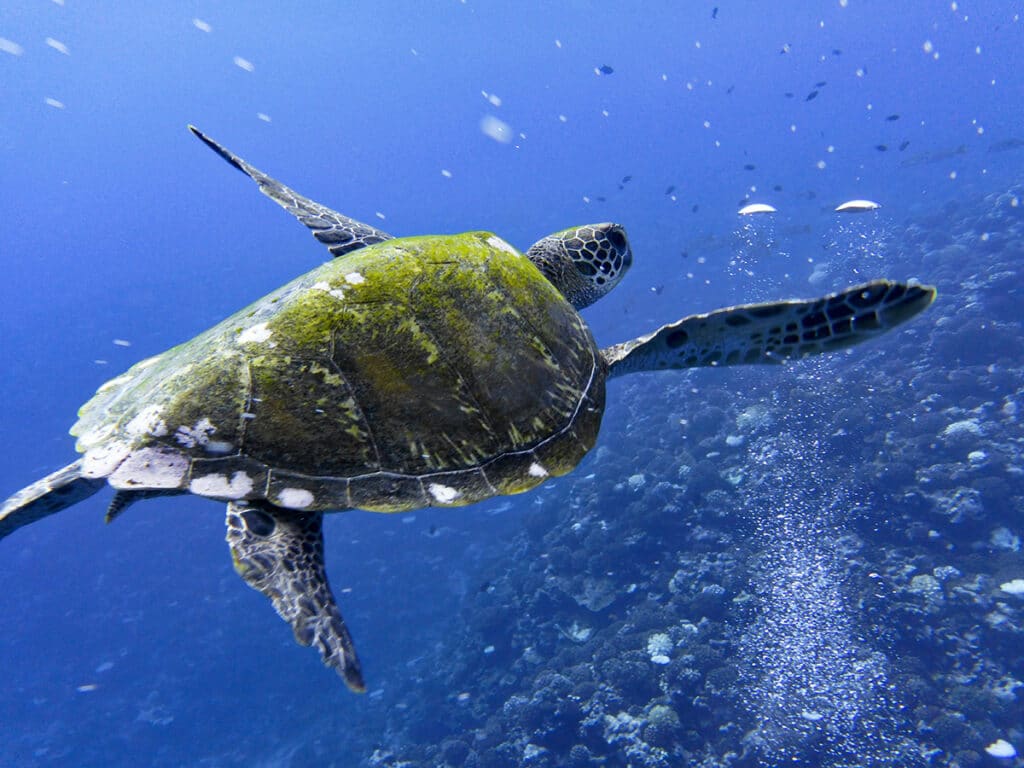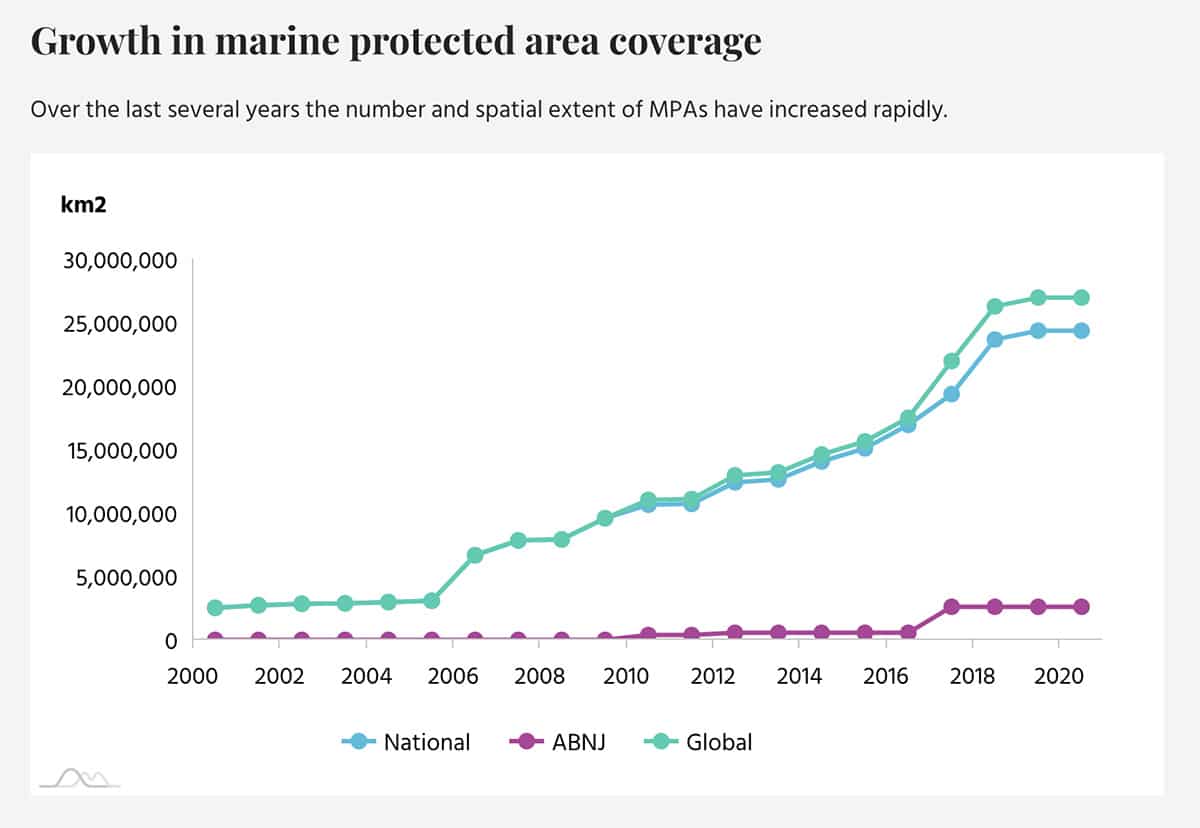Volcanoes are erupting in The Philippines, but on-fire Australia received some welcome rain. The Iran war cries have been called off and The Donald’s military powers are about to be hamstrung by the Senate. Meanwhile, his impeachment trial is starting, and we’re all on Twitter for a front-row seat.
What Could Go Right? The First Treaty to Protect International Waters
Is on the verge of being ratified by the United Nations
This is our weekly newsletter, What Could Go Right? Sign up here to receive it in your inbox every Thursday at 5am ET. You can read past issues here.
The First Treaty to Protect International Waters
In a satirical social media video, an alien spaceship parks above the Earth. It sits there, hovering, for six months, while the planet below devolves into World War III—a fight over which country will send an ambassador to meet with the aliens. With the mushroom cloud of a nuclear bomb in the background, humans are at first outraged but then thrilled to see the aliens suddenly fly away.
The short movie ends with a clip of a stand-up comedian. “Honestly, I don’t blame the aliens for leaving,” he says. “Because if I saw Earth trying to agree on anything, I’d leave, too.”
The video plays on a narrative of humanity we can all relate to: petty, fractured, ineffective. And it is pretty funny.
But is it true? It is and is not. We can certainly be all of the above and worse. We’re also able to come together to a degree not often acknowledged. I am thinking about that juxtaposition this week as the United Nations (UN) meets at the Ocean Conference in Nice, France.
The centerpiece of the conference is the ratification of the High Seas Treaty, adopted by the UN in 2023. Sixty countries must ratify the treaty in order for it to take effect, and we’re almost there. As of this morning, 51 countries have already done so, and French President Emmanuel Macron says that 30 more are in process. So it looks like the world will have a treaty to protect the high seas—international waters that are not governed by any one country and which make up two-thirds of the ocean—for the very first time by early 2026. It will become more effective the more countries that ratify it, of course.

The treaty will establish a process for proposing and creating marine protected areas (MPAs), where conservation rules around environmentally destructive activities like deep-sea mining and overfishing can be set. Any country that is a party to the treaty can propose a new MPA, and the rest of the signees will vote on it.
MPAs are a standout in the UN’s list of 17 Sustainable Development Goals. They have increased by over 160 percent since 2015 and are on track to nearly quadruple by 2030. New ones are announced fairly frequently, although not frequently enough to meet international targets. French Polynesia, for example, just announced the world’s largest—5 million square kilometers, or 1.9 million square miles—this week at the conference.

MPAs are usually established within national boundaries, however, generally within 200 nautical miles of the shore. While some do exist on the high seas, they are scattered. The treaty will allow for the creation of more thorough coverage.

The treaty does a few other things. Signees must conduct environmental impact assessments for activities planned in the waters outside of a country’s national jurisdiction. It also sets up a “benefit-sharing” agreement for any discoveries made in international waters—specifically, marine genetic material like bacteria, coral, or sponges that can be used in pharmaceuticals, biotechnology, cosmetics, and so on. The idea is to cut developing countries, which may not have the resources to make their own discoveries, into the deal, although what that will actually look like in practice is unclear.
One other notable is the speed by which this treaty has moved through the UN. The Associated Press reports that UN Secretary-General António Guterres “called the pace of progress ‘a record,’” with only two years passing between the treaty’s introduction and its ratification. The last sea treaty took 12 years to pass from its introduction to the UN in 1982.
The United States has not yet ratified the treaty, and it is unlikely to do so given President Trump’s executive order from April to fast-track deep-sea mining in international waters. In the meantime, the world is moving on.
At a press conference Wednesday, France’s ecological transition minister, Agnés Pannier-Runacher, said that 10 percent of the world’s oceans are “certainly” covered by MPAs, “but most likely 12 percent.” That is still far from the UN’s goal of protecting 30 percent of them by 2030, but additional pledges were made at the conference, so that number is set to rise. While no UN treaty is perfect either in concept or implementation, this new one will help, and is historic.
What Could Go Right? S7 E14: Judicial vs. Executive: Preventing a King with Jeffrey Rosen

How is the Constitution interpreted today? Zachary and Emma speak with Jeffrey Rosen, president and CEO of the National Constitution Center and host of its We the People podcast. Jeffrey is also a law professor at George Washington University and author of the upcoming book The Pursuit of Liberty: How Hamilton vs. Jefferson Ignited the Lasting Battle Over Power in America. They discuss the public’s perception of the Supreme Court and its interpretation of the Constitution, a historical look at imperial presidencies, and predictions on how the Supreme Court might rule on President Trump’s executive orders and emergency powers. | Listen now
By the Numbers
0: The number of new coal-fired power plants planned on the entire continent of South America, for the first time in history.
20: The percent drop in homicides over a decade in Brazil, in part due to a non-aggression pact between the country’s two biggest criminal factions as well as an aging population.
85: The percent drop in Bangladesh’s under-five mortality rate since 1979.
Quick Hits
📉 Several countries have recently posted poverty declines. Jamaica’s rate was the lowest ever recorded there, Georgia saw drops across all age groups and in both rural and urban areas, Bhutan has nearly eliminated extreme poverty, and Morocco halved its multidimensional poverty rate, which measures well-being indicators other than income or consumption.
📈 In the first three months of 2025, American workers are saving a record-high 14.3 percent of their income in 401(k) retirement accounts, in line with common financial advice to save 12–15 percent. Standard company contributions are also up.
🦠 HIV’s ability to “hide” itself in certain white blood cells means that it is difficult to fully flush the virus from the body either with its own immune system or with drugs. Researchers in Australia, however, using mRNA-based technology, have found a way to make the virus visible in cells donated by HIV patients, the first step on a long road to potentially find a way to kill it for good.
🏠 The first “wildfire resilient” community is being built in California, north of San Diego. Its homes are designed to retard both flames and wind-blown embers.
☀️ Vatican City has joined a very short list of countries powered entirely by renewables, a dream of the late Pope Francis. It is now run by just one photovoltaic roof on a Vatican-owned property on the outskirts of Rome.
👧 The routine termination of female fetuses has slowed dramatically as parents’ preference for a boy fades worldwide—this year, there are likely to be 200,000 “missing” girls among the number of babies born globally, given the natural sex ratio at birth. In 2000, that number was 1.6 million. The Economist reports on both this positive development and the ethical questions around what comes next.
🔬 Eight years ago, Chinese scientists studying CAR-T therapy for treating multiple myeloma, a common but deadly blood cancer, published results so good that American scientists didn’t believe they were real. Now, the cancer is no longer a guaranteed death sentence.
💡 Editor’s pick: Is it possible for countries’ health systems to become self-sufficient after the cuts to US funding? STAT News looks to Thailand for an example of how it can be done.
TPN Member Originals
(Who are our Members? Get to know them.)
- The problem-solving animal, part 1 | The Roots of Progress | Jason Crawford
- Trump’s gilded gut instinct | NYT ($) | Thomas L. Friedman
- $300 Ukrainian drones vs. $100 million Russian bombers | GZERO | Ian Bremmer
- Yes, DOGE failed—and it matters | Slow Boring | Matthew Yglesias
- “The whole government is DOGE now”: The coup’s second wave begins | Lucid | Ruth Ben-Ghiat
- Trump is right about affirmative action, but for the wrong reasons | The Atlantic ($) | Thomas Chatterton Williams
- The Democrats’ problems are bigger than you think | NYT ($) | David Brooks
- What’s so problematic about ‘problematic’? | NYT ($) | John McWhorter
- The insiders | No Mercy/No Malice | Scott Galloway
- There’s a lot of money out there | The Edgy Optimist | Zachary Karabell
- Why Wittgenstein was right about silence | The Atlantic ($) | Arthur C. Brooks
- The Los Angeles protests | Tangle | Isaac Saul
- Musk’s meltdown | Diane Francis | Diane Francis


